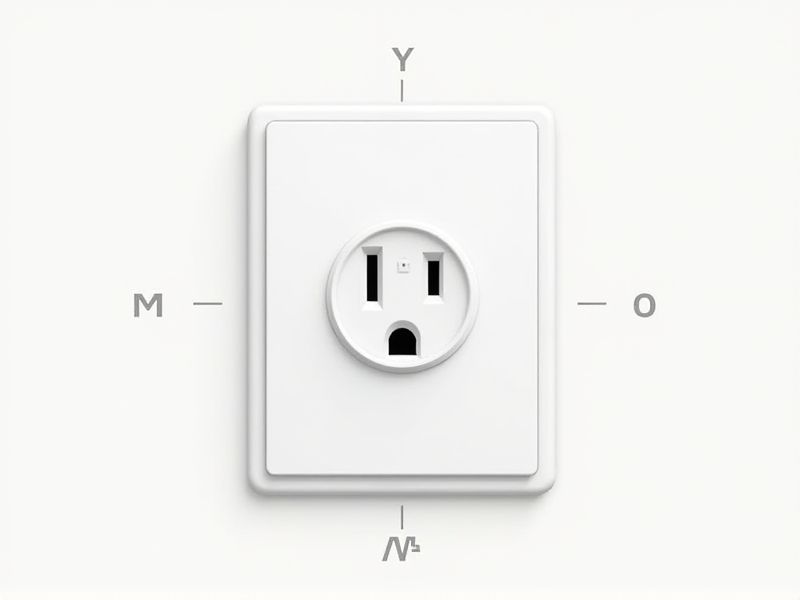
Standard electrical outlets in the United States typically measure about 4.5 inches high by 2.75 inches wide for a standard single-gang wall plate. The actual electrical receptacle that fits inside the wall plate is slightly smaller to allow proper fitting and installation. The distance between the mounting screw holes on a standard outlet is generally 3.28 inches apart, centered vertically. Knowing these standard dimensions is helpful when purchasing replacement parts or planning for new installations to ensure compatibility with existing outlets and wall plates.
Faceplate Dimensions
The faceplate dimensions for standard electrical outlets typically measure 2.75 inches by 4.5 inches. This size accommodates a variety of outlet configurations, including duplex and GFCI outlets. For a seamless installation, the mounting holes are generally positioned 3.2 inches apart from center to center. Ensuring your faceplate aligns with these measurements will help maintain both functionality and aesthetic appeal in your electrical setup.
Height Above Floor
The standard height for electrical outlets in residential buildings typically ranges from 12 to 18 inches above the finished floor. This height ensures convenience for access and aligns with the Americans with Disabilities Act (ADA) recommendations for accessibility. In kitchens, outlets may be positioned higher, around 18 to 24 inches, to accommodate countertops and appliances. For your home, consider adhering to these standards to optimize functionality and safety.
Minimum Wall Space Requirements
Electrical outlets must adhere to minimum wall space requirements to ensure safety and accessibility. In residential settings, the National Electrical Code (NEC) recommends placing outlets every 12 feet along walls, with at least one outlet located within 6 feet of any entrance to a room. This spacing allows for convenient access to power for your devices, reducing the reliance on extension cords. Proper outlet placement minimizes hazards and improves the overall functionality of your electrical system.
Outlet Box Size
The standard electrical outlet box size for residential installations typically measures 4 inches by 4 inches, with a depth of at least 2.5 inches to accommodate various wiring configurations and devices. You should ensure that the box can safely house up to 12 AWG wire, capable of handling up to 20 amps of current. Additionally, the National Electrical Code (NEC) stipulates that outlet boxes must be securely fastened to a wall stud or support structure to prevent any movement during use. For installations requiring multiple outlets or receptacles, consider using larger boxes or gang boxes, which provide ample space and comply with safety regulations.
Center-To-Center Spacing
The standard center-to-center spacing for electrical outlets in residential settings is typically 12 inches, ensuring efficient placement and accessibility. This measurement also accommodates various electrical devices, including plugs and chargers, reducing strain on outlets. In commercial spaces, the spacing may vary based on design regulations, often set at 18 inches for enhanced convenience and compliance. When planning your electrical layout, adhere to these spacing guidelines to promote safety and functionality.
Depth Of Installation
The standard depth of installation for electrical outlets typically ranges from 1.5 to 2.5 inches from the finished wall surface, ensuring optimal functionality and safety. Proper depth is crucial to accommodate various outlet types, including standard, GFCI, and AFCI, while allowing for the secure placement of wires. For residential applications, the National Electrical Code (NEC) recommends maintaining this depth to minimize risks of electrical hazards. When planning your outlet installation, paying attention to these depth specifications can significantly enhance both safety and accessibility.
Receptacle Type Fit
The standard electrical outlet in North America typically features a 15-amp, 120-volt receptacle type, designed to accommodate two flat parallel slots and a grounding hole for safety. In contrast, a 20-amp outlet will have a T-shaped slot, allowing it to fit devices requiring higher current demands. You should ensure that your appliances are compatible with the designated outlet type to avoid damage and potential hazards. Adhering to national electrical codes, the placement height for these outlets is usually between 12 to 18 inches from the floor, optimizing accessibility and convenience for users.
Horizontal And Vertical Alignment
The standard electrical outlet typically adheres to specific measurements, ensuring a height of 12 to 18 inches from the floor for optimal accessibility and convenience. The horizontal alignment is critical, with outlets spaced a minimum of 12 inches apart in living spaces to prevent overcrowding and facilitate proper air circulation around devices. Vertical placement should align with stud centers, usually 16 inches apart, to ensure secure installation. When positioning outlets in kitchens or bathrooms, local codes may require installation at least 48 inches above the floor to reduce water exposure risks.
Plug Clearance Space
The standard electrical outlet has a plug clearance space that is essential for safety and functionality. Typically, the clearance height should be at least 12 inches above the floor to accommodate various plug sizes and ensure accessibility. For residential wiring, the outlet is usually rated at 15 or 20 amps, with a nominal voltage of 120 volts in North America. When positioning your outlets, consider the need for additional space around plugs to allow for heat dissipation and prevent potential hazards.
Mounting Method Compatibility
Electrical outlet standards emphasize the importance of mounting method compatibility, ensuring safer and more efficient installations. For instance, a typical NEMA 5-15R outlet requires a mounting bracket compatible with various wall types, supporting installation heights between 12 to 18 inches from the floor. The National Electric Code (NEC) outlines specific requirements that must be followed to ensure compliance and safety in residential settings. Understanding these mounting standards aids in selecting the right outlet for your electrical needs, ultimately enhancing functionality and safety in your environment.
